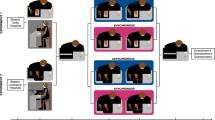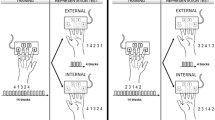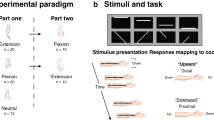Abstract
Localizing and reacting to tactile events on our skin requires the coordination between primary somatotopic projections and an external representation of space. Previous research has attributed an important role to early visual experience in shaping up this mapping. Here, we addressed the role played by immediately available visual information about body posture. We asked participants to determine the temporal order of two successive tactile events delivered to the hands while they adopted a crossed or an uncrossed-hands posture. As previously found, hand-crossing led to a dramatic impairment in tactile localization, which is a phenomenon attributed to a mismatch between somatotopic and externally-based frames of reference. In the present study, however, participants watched a pair of rubber hands that were placed either in a crossed or uncrossed posture (congruent or incongruent with the posture of their own hands). The results showed that the crossed-hands deficit can be significantly ameliorated by the sight of uncrossed rubber hands (Experiment 1). Moreover, this visual modulation seemed to depend critically on the degree to which the visual information about the rubber hands can be attributed to one’s own actions, in a process revealing short-term adaptation (Experiment 2).





Similar content being viewed by others
Notes
The body is in a typical posture when the left limbs are placed on the left of the body and vice versa for the right limbs.
In fact, in order to confirm this, we also explored the data using a 2-parameter model. The analysis of this condition results in a very significant, but clearly artifactual, difference in terms of time constant (P < 0.001).
Statement #1 (“I felt as if my hands were uncrossed”); #2 (“It seemed as if the hand which pressed the top button was my real hand”) #3 (“I felt as if the rubber hands were my hands”) #4 (“It appeared as if my hands (under the box) were displacing towards the top (above the box)”), #5 (“It seemed as if I might have two right hands or two left hands”), #6 (“I felt as if my (real) hands were turning ‘rubbery’”) and #7 (“It appeared (visually) as if the rubber hands (on the top of the box) were displacing towards the bottom (towards my real hands)”).
Abbreviations
- JND:
-
Just noticeable difference
- LED:
-
Light-emitting diode
- PSS:
-
Point of subjective simultaneity
- SI:
-
Primary somatosensory cortex
- SOA:
-
Stimulus onset asynchrony
- TOJ:
-
Temporal order judgement
References
Aglioti S, Smania N, Peru A (1999) Frames of reference for mapping tactile stimuli in brain-damaged patients. J Cogn Neurosci 11(1):67–79
Armel KC, Ramachandran VS (2003) Projecting sensations to external objects: evidence from skin conductance response. Proc Biol Sci 270(1523):1499–1506
Austen EL, Soto-Faraco S, Enns JT, Kingstone A (2004) Mislocalizations of touch to a fake hand. Cogn Affect Behav Neurosci 4(2):170–181
Batista AP, Buneo CA, Snyder LH, Andersen RA (1999) Reach plans in eye-centered coordinates. Science 285(5425):257–260
Benedetti F (1985) Processing of tactile spatial information with crossed fingers. J Exp Psychol Hum Percept Perform 11:517–525
Benedetti F (1988) Exploration of a rod with crossed fingers. Percept Psychophys 44:281–284
Berti A, Frassinetti F (2000) When far becomes near: remapping of space by tool use. J Cogn Neurosci 12:415–420
Botvinick M, Cohen J (1998) Rubber hands ‘feel’ touch that eyes see. Nature 391(6669):756
Craig JC (2003) The effect of hand position and pattern motion in temporal order judgements. Percept Psychophys 65(5):779–788
Craig JC, Belser AN (2006) The crossed-hands deficit in tactile temporal-order judgments: the effect of training. Perception 35:1561–1572
Driver J, Grossenbacher PG (1996) Multimodal spatial constraints on tactile selective attention. In: Inui T, McClelland JL (eds) Attention and performance XVI: information integration in perception and communication. MIT Press, Cambridge, pp 209–235
Efron B, Tibshirani RJ (1993) An introduction to the bootstrap. Chapman and Hall, New York
Ehrsson HH, Holmes NP, Passingham RE (2005) Touching a rubber hand: feeling of body ownership is associated with activity in multisensory brain areas. J Neurosci 25(45):10564–10573
Facchini S, Aglioti SM (2003) Short term light deprivation increases tactile spatial acuity in humans. Neurology 60(12):1998–1999
Farnè A, Làdavas E (2000) Dynamic size-change of hand peripersonal space following tool use. Neuroreport 11:1645–1649
Gallace A, Spence C (2005) Visual capture of apparent limb position influences tactile temporal order judgments. Neurosci Lett 379(1):63–68
Henri V (1898) Über die Raumwahrnehmung des Tastsinnes: Ein Beitrag zur experimentellen Psychologie [On the spatial perception of the tactile sense: A contribution to experimental psychology]. Reuther & Reichard, Berlin
Holmes NP, Spence C (2004) The body schema and the multisensory representation(s) of peripersonal space. Cogn Process 5(2):94–105
Holmes NP, Spence C (2005) Visual bias of unseen hand position with a mirror: spatial and temporal factors. Exp Brain Res 166(3–4):489–497
Holmes NP, Calvert GA, Spence C (2004) Extending or projecting peripersonal space with tools? Multisensory interactions highlight only the distal and proximal ends of tools. Neurosci Lett 372:62–67
Iriki A, Tanaka M, Iwamura Y (1996) Coding of modified body schema during tool use by macaque postcentral neurones. Neuroreport 7(14):2325–2330
Kanai R, Sheth BR, Shimojo S (2004) Stopping the motion and perceptual mislocalization. Vision Res 44:2605–2619
Kauffman T, Theoret H, Pascual-Leone A (2002) Braille character discrimination in blindfolded human subjects. Neuroreport 13(5):571–574
Kitazawa S (2002) Where conscious sensation takes place. Conscious Cogn 11:475–477
Kóbor I, Furedi L, Kovacs G, Spence C, Vidnyanszky Z (2006) Back-to-front: improved tactile discrimination performance in the space you cannot see. Neurosci Lett 400(1–2):163–167
Lakatos S, Shepard RN (1997) Time–distance relations in shifting attention between locations on one’s body. Percept Psychophys 59:557–566
Lloyd D (2007) Spatial limits on referred touch to an alien limb may reflect boundaries of visuo-tactile peripersonal space surrounding the hand. Brain Cogn (in press)
Lloyd D, Morrison I, Roberts N (2006) Role for human posterior parietal cortex in visual processing of aversive objects in peripersonal space. J Neurophysiol 95(1):205–214
Maravita A, Iriki A (2004) Tools for the body (schema). Trends Cogn Sci 8:79–86
Maravita A, Husain M, Clarke K, Driver J (2001) Reaching with a tool extends visual–tactile interactions into far space: evidence from cross-modal extinction. Neuropsychologia 39:580–585
Maravita A, Clarke K, Husain M, Driver J (2002a) Active tool use with the contralesional hand can reduce cross-modal extinction of touch on that hand. Neurocase 8:411–416
Maravita A, Spence C, Kennett S, Driver J (2002b) Tool-use changes multimodal spatial interactions between vision and touch in normal humans. Cognition 83:B25–B34
Maravita A, Spence C, Sergent C, Driver J (2002c) Seeing your own touched hands in a mirror modulates cross-modal interactions. Psychol Sci 13(4):350–355
Moscovitch M, Behrmann M (1994) Coding of spatial information in the somatosensory system: evidence from patients with neglect following parietal lobe damage. J Cogn Neurosci 6:151–155
Pallier C, Dupoux E, Jeannin X (1997) Expe5: an expandable programming language for on-line psychological experiments. Behav Res Methods Instrum Comput 29:322–327
Pavani F, Spence C, Driver J (2000) Visual capture of touch: out-of-the-body experiences with rubber gloves. Psychol Sci 11(5):353–359
Penfield W, Rasmussen T (1950) The cerebral cortex of man: a clinical study of localization of function. Hafner, New York
Ponzo M (1910) Intorno ad alcune illusioni nel campo delle sensazioni tattili, sull’illusione di Aristotele e fenomeni analoghi [On some tactile illusions, Aristotle’s illusion, and similar phenomena]. Archiv für die Gesamte Psychologie 16:307–345
Pouget A, Ducom JC, Torri J, Bavelier D (2002) Multisensory spatial representations in eye-centered coordinates for reaching. Cognition 83(1):B1–B11
Rinker MA, Craig JC (1994) The effect of spatial orientation on the perception of moving tactile stimuli. Percept Psychophys 56:356–362
Röder B, Rösler F, Spence C (2004) Early vision impairs tactile perception in the blind. Curr Biol 14:121–124
Schicke T, Röder B (2006) Spatial remapping of touch: confusion of perceived stimulus order across hand and foot. Proc Natl Acad Sci USA 103(31):11808–11813
Shore DI, Spry E, Spence C (2002) Confusing the mind by crossing the hands. Cogn Brain Res 14(1):153–163
Shore DI, Gray K, Spry E, Spence C (2005) Spatial modulation of tactile temporal-order judgments. Perception 34:1251–1262
Smania N, Aglioti S (1995) Sensory and spatial components of somaesthesic deficits following right brain damage. Neurology 45:1725–1730
Soto-Faraco S, Ronald A, Spence C (2004) Tactile selective attention and body posture: assessing the multisensory contributions of vision and proprioception. Percept Psychophys 66(7):1077–1094
Spence C, Baddeley R, Zampini M, James R, Shore DI (2003) Multisensory temporal order judgments: when two locations are better than one. Percept Psychophys 65(2):318–328
Sutherland MT (2006) The hand and the ipsilateral primary Somatosensory Cortex. J Neurosci 26(32):8217–8218
Tipper SP, Phillips N, Dancer C, Lloyd D, Howard LA, McGlone F (2001) Vision influences tactile perception at body sites that cannot be viewed directly. Exp Brain Res 39:160–167
Wada M, Yamamoto S, Kitazawa S (2004) Effects of handedness on tactile temporal order judgment. Neuropsychologia 42:1887–1895
Yamamoto S, Kitazawa S (2001) Reversal of subjective temporal order due to arm crossing. Nat Neurosci 4:759–765
Zampini M, Brown T, Shore DI, Maravita A, Röder B, Spence C (2005a) Audiotactile temporal order judgments. Acta Psychol (Amst) 118(3):277–291
Zampini M, Harris C, Spence C (2005b) Effect of posture change on tactile perception: impaired direction discrimination performance with interleaved fingers. Exp Brain Res 166:498–508
Acknowledgments
This work was supported by a grant from the Spanish Ministerio de Educación y Ciencia TIN2004-04363-C03-02. E.A. is supported by a fellowship Beca de Formación de Profesorado Universitario from the Spanish Ministerio de Educación y Ciencia. We would like to thank Joan López-Moliner for his valuable help with the data analyses. We would also like to thank Mikel Santesteban and Aida Mallorquí.
Author information
Authors and Affiliations
Corresponding author
Rights and permissions
About this article
Cite this article
Azañón, E., Soto-Faraco, S. Alleviating the ‘crossed-hands’ deficit by seeing uncrossed rubber hands. Exp Brain Res 182, 537–548 (2007). https://doi.org/10.1007/s00221-007-1011-3
Received:
Accepted:
Published:
Issue Date:
DOI: https://doi.org/10.1007/s00221-007-1011-3




